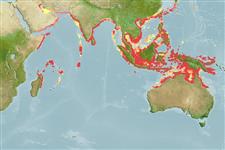Elasmobranchii (hajar och rockor) (sharks and rays) >
Carcharhiniformes (Ground sharks) >
Sphyrnidae (Hammerhead, bonnethead, or scoophead sharks)
Etymology: Eusphyra: eu- (Gr.), good, well or very; sphyra (Gr.), hammer, referring to immense hammer-shaped head. (See ETYFish); blochii: In honor of physician-naturalist Marcus Elieser Bloch (1723-1799), who described and illustrated this shark in 1785, which he identified as Squalus zygaena. (See ETYFish).
More on author: Cuvier.
Environment: milieu / climate zone / depth range / distribution range
Ekologi
marina; brackvatten bentopelagisk; amfidrom (Ref. 51243). Tropical; 31°N - 20°S, 47°E - 154°E
Indo-West Pacific: Persian Gulf to the Philippines, north to China, south to Australia.
Length at first maturity / Size / Vikt / Age
Maturity: Lm ?, range 120 - ? cm
Max length : 186 cm TL hane/ej könsbestämd; (Ref. 6871)
Taggstrålar i ryggfenan (totalt): 0; Mjukstrålar i ryggfenan (totalt): 0; Taggstrålar i analfenan 0; Mjukstrålar i analfenan: 0. Grey or grey-brown above, paler below. Expanded lateral blades of head very narrow and wing-like, with a series of small bumps along edges in front of nostrils; width across head 40 or 50% of total length. Nostrils enormously expanded, each nearly 2 times the mouth head (Ref 13562).
Found in shallow water on continental and insular shelves (Ref. 244). Enters estuaries (Ref. 4832). Feeds mainly on small teleost fishes but also takes crustaceans and cephalopods (Ref. 13562). Viviparous (Ref. 50449), with 6 to 25 pups in a litter (Ref. 6871). Has a remarkable wing-shaped head which is nearly or quite half of its body length, the function of which is uncertain, maybe for maneuvering or for increasing the surface area of some of the sense organs (Ref. 244). Probably harmless to people (Ref. 13562). Caught commonly, but in low numbers, by inshore gillnet fisheries. Particularly common in catches off Kalimantan (Ref.58048). Probably a common fisheries species where it occurs (Ref. 13562). Meat utilized for human consumption; liver is a source of vitamin oil (Ref. 244). Offal probably utilized for fishmeal (Ref. 13562). Reported to reach 300 cm TL (Ref. 58784).
Viviparous, placental (Ref. 50449), with 6 to 25 in a litter after a gestation period of 8 (Ref.58048) -11 months (Ref. 6871). Size at birth between 32 and 45 cm TL (Ref. 13562).
Compagno, L.J.V., 1984. FAO Species Catalogue. Vol. 4. Sharks of the world. An annotated and illustrated catalogue of shark species known to date. Part 2 - Carcharhiniformes. FAO Fish. Synop. 125(4/2):251-655. Rome: FAO. (Ref. 244)
IUCN Red List Status (Ref. 130435)
Human uses
Fiskeri: kommersiell
Ytterligare information
MedarbetareBilderStamps, Coins Misc.LjudCiguateraHastighetSimsättGälytaOtolithsHjärnstorlekSyn
Verktyg
Special reports
Download XML
Internet-källor
Estimates based on models
Preferred temperature (Ref.
123201): 25.2 - 29.1, mean 28.3 °C (based on 970 cells).
Phylogenetic diversity index (Ref.
82804): PD
50 = 1.0010 [Uniqueness, from 0.5 = low to 2.0 = high].
Bayesian length-weight: a=0.00513 (0.00275 - 0.00956), b=3.24 (3.07 - 3.41), in cm total length, based on LWR estimates for this species & (Sub)family-body (Ref.
93245).
Trofisk nivå (Ref.
69278): 4.2 ±0.6 se; based on diet studies.
Resiliens (Ref.
120179): Mycket låg, lägsta populationsfördubblingstid mer än 14 år (Fec=6).
Fishing Vulnerability (Ref.
59153): Very high vulnerability (90 of 100).
Nutrients (Ref.
124155): Calcium = 16.6 [2.7, 88.0] mg/100g; Iron = 0.526 [0.132, 1.586] mg/100g; Protein = 18.9 [16.9, 21.1] %; Omega3 = 0.129 [0.056, 0.295] g/100g; Selenium = 76.7 [22.3, 229.5] μg/100g; VitaminA = 19 [8, 48] μg/100g; Zinc = 0.721 [0.349, 1.352] mg/100g (wet weight);
